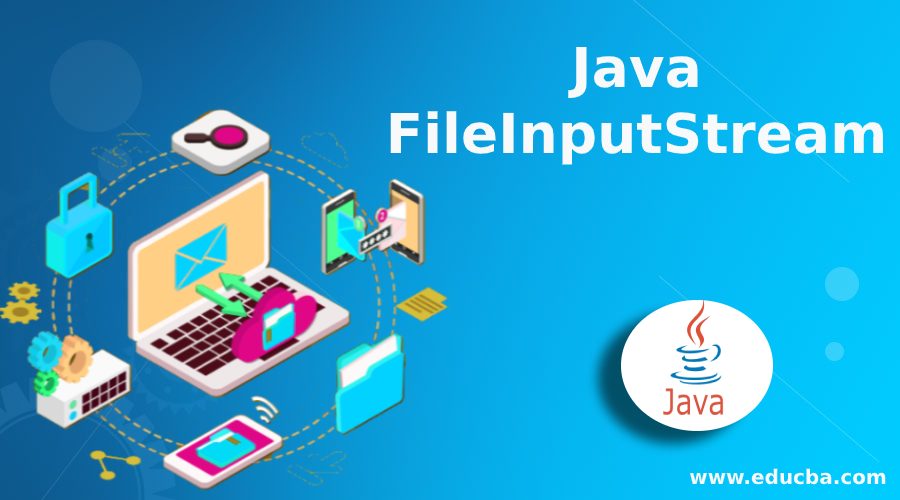Updated April 5, 2023

Introduction to Java FileInputStream
Java FileInputStream is a class that is used to read data and the streams of bytes from the file. The FileInputStream class is a built-in class in java that defines the java.io.FileInputStream package. The InputStream is a superclass of the FileInputStream. The FileInputStream class is used to reads the streams of raw bytes (byte by byte) like an image data video, audio, etc., whereas to read streams of characters (character by character), we can use FileReaderbuiltin class.
The declaration syntax of the FileInputStream class in java:
The following is the declaration forjava.io.FileInputStream class.
public class FileInputStream extends InputStream
{
// Constructors and methods of the FileInputStream class
}The above is the syntax of the FileInputStream, where it is extended to the InputStream class.
FileInputStreamclass member Functions : The FileInputStream class contains constructors and some functions as a FileInputStream class member function.
Constructors of Java FileInputStream Class
- FileInputStream(File file ): This constructor creates an instance of FileInputstreamby opening a connection to a specified file to read from this instance.
- FileInputStream(FileDescriptorfdobj): This constructor creates an instance of FileInputstream by using the file descriptor fdobj, which specifies an existing connection to an actual specified file in the file system to read from this instance.
- FileInputStream(String fname): This constructor creates an instance of FileInputstream by opening a connection to a specified file fname parameter to read from this instance.
Functions of Java FileInputStream Class
Function and syntax are given below:
1. read()
This function is used to read a byte of data from the input stream.
public int read() throws IOException2. read(byte[] b )
This function is used to read bytes of data up to b array size from the input stream.
public int read(byte[] b)throws IOException3. read(byte[] b, int off, intlen)
This function is used to read bytes of data from the input stream up to specified len into destination b array at start offset.
public int read(byte[] b, int offset, intlen) throws IOException4. available()
This function is used to return the estimated number of bytes that can be read from the input stream.
public int available() throws IOException5. skip( long n )
This function is used to skip n bytes of data from the input stream.
public long skip(long n) throws IOException6. getChannel()
This function is used to get the unique FileChannel object of the file input stream.
public FileChannelgetChannel()7. finalize()
This function is used to ensure that when there is no more reference, the file input stream’s close method is to be called.
protected void finalize() throws IOException8. getFD() – T
his function is used to get the FileDescriptor object, which specifies the connection to the file system’s actual file.
public final FileDescriptorgetFD() throws IOException9. close()
This function is used to close the File stream and release the resource file.
public void close() throws IOExceptionFunctions and Examples of File Input Stream Class
Working and examples for the FileInputStream class and its methods in java:
Next, we write the java code to understand the FileInputStream class more clearly with the following example where we create a FileInputStream object by using the FileInputStream class constructor and pass the file name to read a character, as below –
Example #1
Code:
//package p1;
import java.io.FileInputStream;
public class Demo {
public static void main( String[] arg) {
int i;
char c;
try{
// create object of file input stream by opening connection data.txt file
FileInputStream fobj=new FileInputStream("D:\\data.txt");
// data.txt file contain "Hello!, How are you?" data in it
i = fobj.read();
c = (char) i;
System.out.println("The First byte is :" +c);
System.out.println("The Number of remaining bytes are :" +fobj.available());
// skip method to skip 3 bytes
fobj.skip(3);
i = fobj.read();
// converts byte to character
c = (char) i;
System.out.println("The Next byte after 3 byte skip is :" +c);
fobj.close();
}catch(Exception e)
{
System.out.println(e);
}
}
}Output:
Example #2
Next, we write the java code to understand the FileInputStream class more clearly; we create an FileInputStream object to read all characters from the file, as below:
Code:
//package p1;
import java.io.FileInputStream;
public class Demo {
public static void main( String[] arg) {
int i;
char c;
// create object of file input stream by opening connection data.txt file
try {
FileInputStream fobj=new FileInputStream("D:\\data.txt");
// data.txt file contain "Hello!, How are you?" data in it
while((i = fobj.read())!=-1)
{
c = (char) i;
System.out.print(c);
}
// getChannel() method
System.out.println("\nThe unique FileChannel object is : " +fobj.getChannel());
// getFD() method
System.out.println("The FileDescriptor object is : " +fobj.getFD());
fobj.close();
}catch(Exception e)
{
System.out.println(e);
}
}
}Output:
Example #3
Next, we write the java code to understand the FileInputStream class where we read the data into the byte array, and we extend the user define class to FileInputStream class to use the finalize() method, as below –
Code:
//package p1;
import java.io.FileInputStream;
public class Demo extends FileInputStream {
public Demo(String file) throws Exception {
super(file);
}
public static void main( String[] arg) {
byte[] b = new byte[16];
int i;
char c;
// create object of file input stream by opening connection data.txt file
try {
Demo fobj=new Demo("D:\\data.txt");
// data.txt file contain "Hello!, How are you?" data in it
i = fobj.read(b, 1, 15);
System.out.println("The total bytes read are : "+i);
System.out.print("The bytes read are : ");
for(byte t : b) {
c = (char)t;
System.out.print(c);
}
// finalize() method
fobj.finalize();
fobj.close();
}catch(Exception e)
{
System.out.println(e);
}
}
}Output:
Recommended Articles
This is a guide to Java FileInputStream. Here we also discuss the Introduction and functions of the java fileinputstream class along with different examples and its code implementation. You may also have a look at the following articles to learn more –




